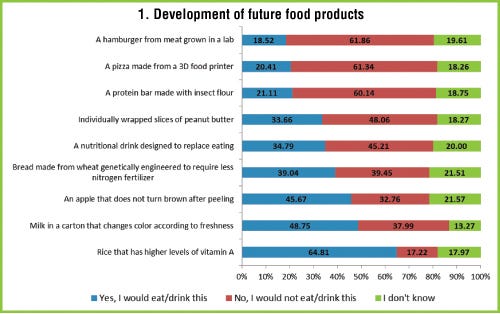U.S. consumers believe a more "natural" agriculture system will solve the future food challenges.

The future is always filled with uncertainty, especially for individuals involved in growing and producing safe, nutritional food for the world.
As the agriculture community, spends a great deal of time and effort in pondering the “what ifs”, consumers still sit in the driver seat.
One thing futuristic minds can agree on is the world population clock is clicking away at much quicker rate than the U.S. population. Recent estimates show a global population will not slow down its pace even after it reaches the United Nation’s projection of 9.2 billion in 2050. For now, the drop in global population is not predicted to occur until after 2100.

Figure 1: Development of Future Food Products
As more people inhibit the planet, more food will need to be produced with the same or less amount of available land. Clearly, innovation and smart approaches will be necessary for the agriculture community to accomplish the feat at hand.
Nevertheless, opinions vary across scientists, agriculture community and consumers on how to solve the future food puzzle.
Depending on perspective, some are pushing for food products that are derived from unconventional methods like meat from a test tube, pizza from 3D printer or protein bar from insect flour. While others think the answer lies in returning back to simpler food production system.
Still, when it is all's said and done, the consumer will hold the last piece of the puzzle by purchasing or not purchasing the food produced today and tomorrow.
That is exactly why Jayson Lusk, Oklahoma State University food and agriculture economists and his researchers asked U.S. consumers about the future of food in the December Food Demand Survey (FooDS).

Figure 2: Food and Agricultural challenges
When survey participants were asked if they would eat the future food products currently being developed by scientists, only 18.52% would eat hamburger from meat grown in the lab. Slightly more, 20.41% said they would consume pizza from a 3-D food printer and 21.11% would eat protein bar made with insect flour. Even so, approximately 80% of the partakers would not eat or do not know if they would eat the three new products (figure 1).
In food products being developed to address food safety concerns or enhance nutritional value, consumers were more open to try the new product. Over 64% of those taking the survey said they would eat rice with higher level of vitamin A. Just under half of the participants would eat an apple that does not turn brown or drink milk in carton that changed color in accordance to freshness.
Next, U.S. consumers were asked about concerns over future food and agriculture challenges.
The top concern was having affordable food for the participant and their family while inequitable distribution of food throughout the world, U.S. food imports and exports and the profitability of U.S. farmers and ranchers ranked lowest, around 8% each. Interestingly, producing enough food for the world or finding ways to prevent adverse environmental impacts only important to 11% and 10% U.S. participants (figure 2).
Finally, survey partakers were asked about future challenges facing food and agriculture. Picking from two available options, more than three-quarters of the consumers polled said adopting a more “natural” agriculture production that includes additional local, organic and unprocessed food over adopting more “technological” agricultural system would be the most effective in addressing the future food challenge.
About the Author(s)
You May Also Like

.png?width=300&auto=webp&quality=80&disable=upscale)

